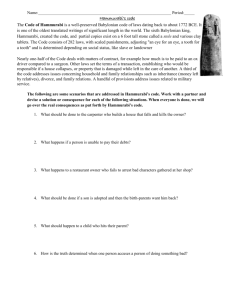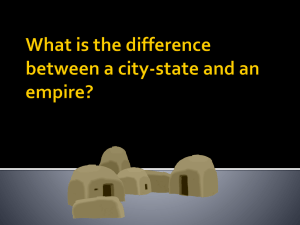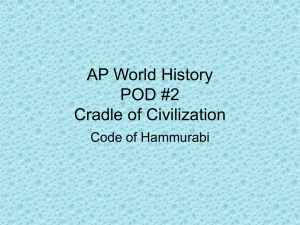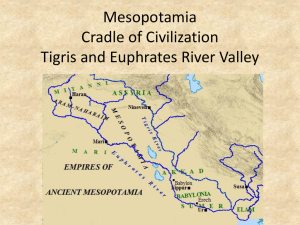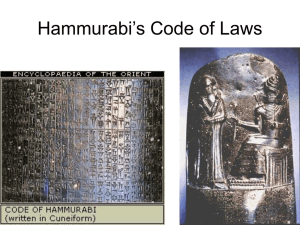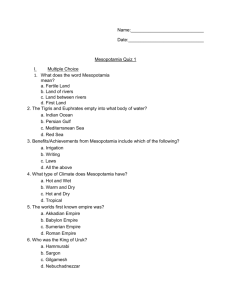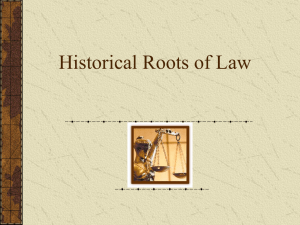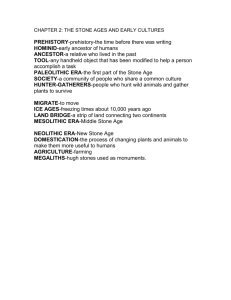Unit 3 - TeacherWeb
advertisement
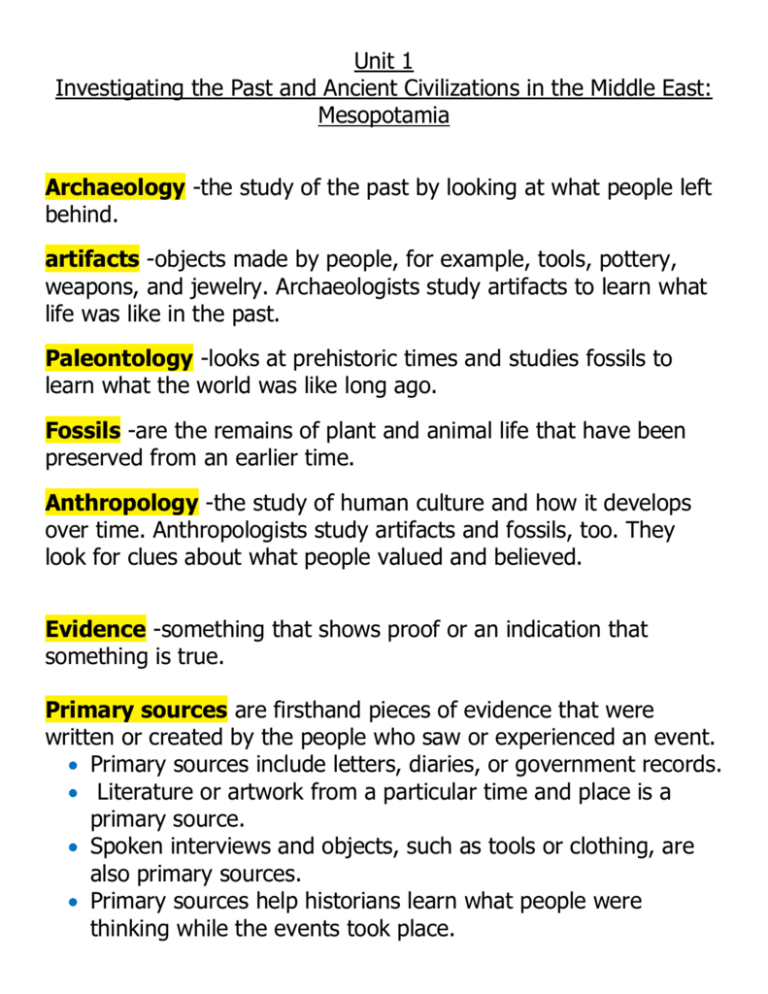
Unit 1 Investigating the Past and Ancient Civilizations in the Middle East: Mesopotamia Archaeology -the study of the past by looking at what people left behind. artifacts -objects made by people, for example, tools, pottery, weapons, and jewelry. Archaeologists study artifacts to learn what life was like in the past. Paleontology -looks at prehistoric times and studies fossils to learn what the world was like long ago. Fossils -are the remains of plant and animal life that have been preserved from an earlier time. Anthropology -the study of human culture and how it develops over time. Anthropologists study artifacts and fossils, too. They look for clues about what people valued and believed. Evidence -something that shows proof or an indication that something is true. Primary sources are firsthand pieces of evidence that were written or created by the people who saw or experienced an event. Primary sources include letters, diaries, or government records. Literature or artwork from a particular time and place is a primary source. Spoken interviews and objects, such as tools or clothing, are also primary sources. Primary sources help historians learn what people were thinking while the events took place. Secondary sources -are created after an event by people who were not part of the historical event. The information in secondary sources is often based on primary sources. Examples are biographies, encyclopedias, history books, and textbooks. Detectives Who Study the Past Social scientists might be: archaeologists who examine artifacts that people have made and left behind, historians who study the written records that people began to leave in the last few thousand years, or geographers who look at the natural and human-made features of Earth. Cave Art Caves have provided clues to the past for social scientists. Cave paintings and sculptures thousands of year old have been found all over the world. Artifacts also have been discovered in caves. The art and artifacts provide information about how people lived long ago. Cave Art Tools Cave artists used sharp stones to grind colored minerals into powder. They mixed the powder with animal fat to create paint. They may have used moss, fur, hollow reeds, or their own hair as paintbrushes. The Five Hominid Groups Scientists call prehistoric humans hominids. “Lucy” and Her Relatives A scientist found the bones of a hominid who lived more than 3 million years ago in Africa. He nicknamed the bones Lucy. Lucy belonged to the group Australopithecus afarensis. She had the capability to walk on two feet, or was biped. Handy Man and Upright Man The group Homo habilis, or Handy Man, was taller than Lucy and had the capability to make simple stone tools. The group Homo erectus, or Upright Man, were the first hominids to migrate out of Africa into Asia and Europe. They stood up straight and had the capability to make tools, fire, and shelters to protect them from the cold. Neanderthal Man and Doubly Wise Man The group scientists called Homo sapiens neanderthalensis, or Neanderthal Man, had large brains, made complex tools, and lived in communities. Homo sapiens sapiens, or Doubly Wise Man, made more complex tools, were skilled hunters, and created artwork. The Old Stone Age, or Paleolithic Age Began about 2 million years ago, with the first tool making hominids, and lasted until about 8000 B.C.E. Early modern humans developed. They were hunter-gatherers. They were nomads and wandered from place to place, hunting animals and gathering plants for food. They took shelter in caves or made rough tent like structures that were temporary. Prehistoric cave painters left clues about their way of life. They discovered fire by friction or striking stones together. Fire provided light, protection from animals and was for cooking. The Ice Ages Long periods of extreme cold that affected all the Earth Thick sheets of ice, or glaciers, moved across the land changing its shape. A land bridge was believed to have formed that connected Asia and North America. This allowed early humans to migrate southward to settle in different regions. Humans survived by adapting: added fat to their diet, built sturdier shelters, used furs for protection, and used fire to stay warm. The New Stone Age, or Neolithic Age Began when people started to farm and produce their own food. The discovery of farming happened over thousands of years. Now, rather than having to roam long distances in search of things to eat, people could settle down in one place. The Neolithic Age began around 8000 B.C.E. and lasted until about 3000 B.C.E., when people learned to make tools out of metal instead of stone (The Bronze Age). Many Neolithic settlements were located in the Fertile Crescent, east of the Mediterranean Sea, where the land was fertile (good for growing crops). Agriculture- the process of changing the environment in order to use it more effectively. The Agricultural Revolution- also known as the Neolithic Revolution, was the transformation of human societies from hunting and gathering to farming. Farming and domestication of plants and animals tied people to the land for cultivation and grazing grounds, and this transition gave rise to permanent settlements, from villages to cities. Domestication- making something useful to humans, for example taming a dog, roping livestock such as a pig or cow, or cross-breeding vegetables to make them bigger. With domesticated plants and animals, villagers had a steady source of food which led to a surplus, extra amounts or more than what is needed. This settlement, in turn, led to the development of job specialization, which meant that not everybody had to do the same thing- they became experts at certain things, such as basket making, craft making, building, or trading. Mesopotamia Mesopotamia refers to the region now occupied by modern Iraq, eastern Syria, and southern Turkey. The name refers to the area between the Euphrates and the Tigris Rivers and means "between two rivers". The fertile area watered by these two rivers is known as the "Cradle of Civilization," or the “Fertile Crescent” and it was here that the first literate societies developed. Sumerians The Beginning of Cities Built the first cities in Mesopotamia around 3500 B.C. Four geographic challenges faced by the Sumerians: 1. Food shortages in the north hills due to lack of land 2. Uncontrolled water supply on the southern plains 3. Difficulties in building and maintaining water systems across village boundaries 4. Attacks by neighboring communities Solved them by: Moving to the southern plains Built dikes or levees, which were walls to hold back floodwater from fields and homes and built canals, dams, and reservoirs to control floods Used water from the reservoirs to irrigate, or bring water to, the fields during the very hot, dry summer months Because of this, farmers produced a surplus, more food than they needed People had various jobs: builders, making pottery, weavers of fine cloth They traded what they made for what they needed Ziggurat Civilization- a society that has developed arts and sciences and organization. It includes: A stable food supply Development of a social structure with specialized skills and different occupations or jobs Organized government Organized religion with beliefs and forms of worship Development of writing and keeping records Development of the Arts, such as painting, architecture, music Create new forms of technology Development of trade Characteristic of a civilization A stable food supply Development of a social structure with specialized skills and different occupations or jobs Organized government Organized religion with beliefs and forms of worship Development of writing and keeping records Sumer Built irrigation systems Invented the plow Had several classes of people: top were priests, landowners, government officials middle were merchants and artisans- or skilled workers, farmers and fishers bottom were slaves Ruled by kings First to develop a system of written laws Scribes recorded laws Believed in gods and tried to please them Built ziggurats which were solid brick platforms of the largest structure in a city. Usually a temple stood on top. Held ceremonies and rituals Created a written language called cuneiform Used a wedge shaped stylus to etch writing in clay tablets Based upon pictographs which were symbols that stood for real objects Development of the Arts, such as painting, architecture, music Create new forms of technology Development of trade Artists and metal artisans made decorative items such as mirrors and jewelry Architects designed temples ad ziggurats Music and musicians with songs an instruments Invented the plow Invented the wheel Created wheeled carts and chariots Invented the arch that added strength and beauty above doorways Trade was centered in the Persian Gulf They traded grain and cloth for things such as wood, gold, gems and animals The Development of Early Writing 1. 2. 3. 4. Pictographs- a picture sign that looked like the thing it stood for. Cuneiform- marks made in clay using a wedge-shaped stick. Looked less like pictures but couldn’t express action. Cuneiform- the symbols became connected to an action. Cuneiform- characters came to stand for sounds/ syllables. Four Empires of Mesopotamia Akkadians Ancient Sumer was conquered aroud2300 B.C.E. and made part of the Akkadian Empire King Sargon was the first ruler Effective military strategies and created the world’s first empire Artists carved three dimensional sculptures on stones called steles. Hammurabi and Babylonia King Hammurabi – king and chief priest of Babylon conquered all of Mesopotamia and made Babylon the capital Ruled for 42 years from around 1792 B.C. to 1750 B.C. Created code of laws to unify his empire and preserve order The oldest set of laws known to exist Created laws that he ordered to be carved on a stone stele and placed in a public place for all to see Said people need to be responsible for their actions For example, if a man’s ox killed another, he had to pay for the dead one The Code of Hammurabi consists of 282 laws, with adjusted punishments, applying "an eye for an eye, a tooth for a tooth" depending on social status, of slave versus free man. It demands a trial by judges. One nearly complete example of the Code survives today, on a stone slab in the shape of a huge index finger, using cuneiform script. Codes protected all classes of Babylonian society, including women and slaves. Hammurabi sought protection of the weak from the powerful and the poor from the rich. Assyrian Empire Rose to power 900 B.C.E. by expanding their territory Feared for military strength and cruelty Created new weapons and war strategies- siege warfare Eventually the Empire grew too big to control Built aqueducts- pipes or channels to carry water NEO-BABYLONIAN EMPIRE Babylonians took control again Established Neo-Babylonian Empire- “Neo” means new King Nebuchadrezzar was a ruthless military leader who ruled from 605 to 562 B.C.E. Rebuilt Babylon like in Hammurabi’s time Created the first sundial Conquered after 75 years by the Persians (today Iran) Hammurabi’s Code is 44 columns of text, 28 paragraphs of which contain the actual code. There are 282 laws (possibly more have been rubbed off) that probably amend common Babylonian law rather than define it. It describes regulations for legal procedure, fixes rates on services performed in most branches of commerce and describes property rights, personal injury, and penalties for false testimony and accusations. It has no laws regarding religion. The Code of Hammurabi is significant because its creation allowed men, women, slaves, and all others to read and understand the laws that governed their lives in Babylon. It is unique in that laws of other civilizations were not written down, and thus could be manipulated to suite the rulers that dictated them. The Code is particularly just for its time. Although it follows the practice of "an eye for an eye", it does not allow for vigilante justice, but rather demands a trial by judges. It also glorifies acts of peace and justice done during Hammurabi’s rule. It symbolizes not only the emergence of justice in the minds of men, but also man’s rise above ignorance and barbarism toward the peaceful and just societies still pursued today. In the words of Hammurabi as carved on the stone, "Let any oppressed man who has a cause come into the presence of my statue as king of justice, and have the inscription on my stele read out, and hear my precious words, that my stele may make the case clear to him; may he understand his cause, and may his heart be set at ease!" The Prologue inscribed in clay. The stone slab shaped like an index finger. The entire code is inscribed on the back. The top depicts Hammurabi receiving the divine laws from the sun god, the god most often associated with justice. This stone was unearthed by French archaeologists in Iraq (ancient Elam), in 1901-02. The black diorite rock is 2.4 m high and had been broken into three pieces. Ziggurat
